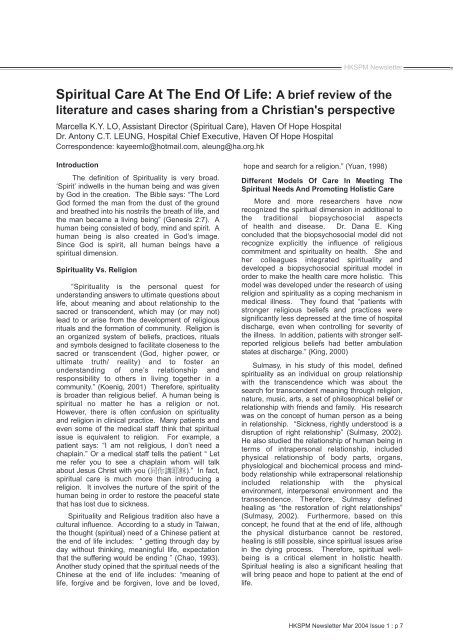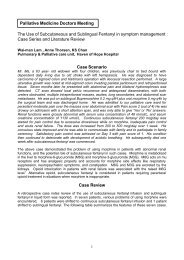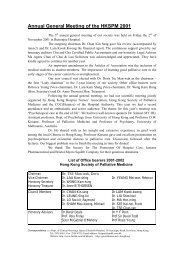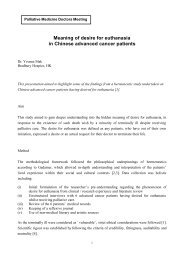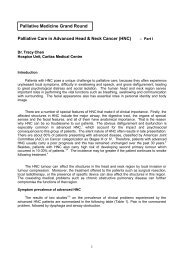Spiritual Care At The End Of Life - Hong Kong Society of Palliative ...
Spiritual Care At The End Of Life - Hong Kong Society of Palliative ...
Spiritual Care At The End Of Life - Hong Kong Society of Palliative ...
Create successful ePaper yourself
Turn your PDF publications into a flip-book with our unique Google optimized e-Paper software.
HKSPM Newsletter<br />
<strong>Spiritual</strong> <strong>Care</strong> <strong>At</strong> <strong>The</strong> <strong>End</strong> <strong>Of</strong> <strong>Life</strong>: A brief review <strong>of</strong> the<br />
literature and cases sharing from a Christian's perspective<br />
Marcella K.Y. LO, Assistant Director (<strong>Spiritual</strong> <strong>Care</strong>), Haven <strong>Of</strong> Hope Hospital<br />
Dr. Antony C.T. LEUNG, Hospital Chief Executive, Haven <strong>Of</strong> Hope Hospital<br />
Correspondence: kayeemlo@hotmail.com, aleung@ha.org.hk<br />
Introduction<br />
<strong>The</strong> definition <strong>of</strong> <strong>Spiritual</strong>ity is very broad.<br />
‘Spirit’ indwells in the human being and was given<br />
by God in the creation. <strong>The</strong> Bible says: “<strong>The</strong> Lord<br />
God formed the man from the dust <strong>of</strong> the ground<br />
and breathed into his nostrils the breath <strong>of</strong> life, and<br />
the man became a living being” (Genesis 2:7). A<br />
human being consisted <strong>of</strong> body, mind and spirit. A<br />
human being is also created in God’s image.<br />
Since God is spirit, all human beings have a<br />
spiritual dimension.<br />
<strong>Spiritual</strong>ity Vs. Religion<br />
“<strong>Spiritual</strong>ity is the personal quest for<br />
understanding answers to ultimate questions about<br />
life, about meaning and about relationship to the<br />
sacred or transcendent, which may (or may not)<br />
lead to or arise from the development <strong>of</strong> religious<br />
rituals and the formation <strong>of</strong> community. Religion is<br />
an organized system <strong>of</strong> beliefs, practices, rituals<br />
and symbols designed to facilitate closeness to the<br />
sacred or transcendent (God, higher power, or<br />
ultimate truth/ reality) and to foster an<br />
understanding <strong>of</strong> one’s relationship and<br />
responsibility to others in living together in a<br />
community.” (Koenig, 2001) <strong>The</strong>refore, spirituality<br />
is broader than religious belief. A human being is<br />
spiritual no matter he has a religion or not.<br />
However, there is <strong>of</strong>ten confusion on spirituality<br />
and religion in clinical practice. Many patients and<br />
even some <strong>of</strong> the medical staff think that spiritual<br />
issue is equivalent to religion. For example, a<br />
patient says: “I am not religious, I don’t need a<br />
chaplain.” Or a medical staff tells the patient “ Let<br />
me refer you to see a chaplain whom will talk<br />
about Jesus Christ with you ().” In fact,<br />
spiritual care is much more than introducing a<br />
religion. It involves the nurture <strong>of</strong> the spirit <strong>of</strong> the<br />
human being in order to restore the peaceful state<br />
that has lost due to sickness.<br />
<strong>Spiritual</strong>ity and Religious tradition also have a<br />
cultural influence. According to a study in Taiwan,<br />
the thought (spiritual) need <strong>of</strong> a Chinese patient at<br />
the end <strong>of</strong> life includes: “ getting through day by<br />
day without thinking, meaningful life, expectation<br />
that the suffering would be ending ” (Chao, 1993).<br />
Another study opined that the spiritual needs <strong>of</strong> the<br />
Chinese at the end <strong>of</strong> life includes: “meaning <strong>of</strong><br />
life, forgive and be forgiven, love and be loved,<br />
hope and search for a religion.” (Yuan, 1998)<br />
Different Models <strong>Of</strong> <strong>Care</strong> In Meeting <strong>The</strong><br />
<strong>Spiritual</strong> Needs And Promoting Holistic <strong>Care</strong><br />
More and more researchers have now<br />
recognized the spiritual dimension in additional to<br />
the traditional biopsychosocial aspects<br />
<strong>of</strong> health and disease. Dr. Dana E. King<br />
concluded that the biopsychosocial model did not<br />
recognize explicitly the influence <strong>of</strong> religious<br />
commitment and spirituality on health. She and<br />
her colleagues integrated spirituality and<br />
developed a biopsychosocial spiritual model in<br />
order to make the health care more holistic. This<br />
model was developed under the research <strong>of</strong> using<br />
religion and spirituality as a coping mechanism in<br />
medical illness. <strong>The</strong>y found that “patients with<br />
stronger religious beliefs and practices were<br />
significantly less depressed at the time <strong>of</strong> hospital<br />
discharge, even when controlling for severity <strong>of</strong><br />
the illness. In addition, patients with stronger selfreported<br />
religious beliefs had better ambulation<br />
states at discharge.” (King, 2000)<br />
Sulmasy, in his study <strong>of</strong> this model, defined<br />
spirituality as an individual on group relationship<br />
with the transcendence which was about the<br />
search for transcendent meaning through religion,<br />
nature, music, arts, a set <strong>of</strong> philosophical belief or<br />
relationship with friends and family. His research<br />
was on the concept <strong>of</strong> human person as a being<br />
in relationship. “Sickness, rightly understood is a<br />
disruption <strong>of</strong> right relationship” (Sulmasy, 2002).<br />
He also studied the relationship <strong>of</strong> human being in<br />
terms <strong>of</strong> intrapersonal relationship, included<br />
physical relationship <strong>of</strong> body parts, organs,<br />
physiological and biochemical process and mindbody<br />
relationship while extrapersonal relationship<br />
included relationship with the physical<br />
environment, interpersonal environment and the<br />
transcendence. <strong>The</strong>refore, Sulmasy defined<br />
healing as “the restoration <strong>of</strong> right relationships”<br />
(Sulmasy, 2002). Furthermore, based on this<br />
concept, he found that at the end <strong>of</strong> life, although<br />
the physical disturbance cannot be restored,<br />
healing is still possible, since spiritual issues arise<br />
in the dying process. <strong>The</strong>refore, spiritual wellbeing<br />
is a critical element in holistic health.<br />
<strong>Spiritual</strong> healing is also a significant healing that<br />
will bring peace and hope to patient at the end <strong>of</strong><br />
life.<br />
HKSPM Newsletter Mar 2004 Issue 1 : p 7
HKSPM Newsletter<br />
One <strong>of</strong> the most significant spiritual sufferings<br />
at the end <strong>of</strong> life is existential suffering. Chochinov<br />
and his colleagues studied the notion <strong>of</strong> dying with<br />
dignity. <strong>The</strong>y developed a dignity-conserving<br />
model <strong>of</strong> end <strong>of</strong> life care including the issues <strong>of</strong><br />
hope, meaning, purpose and dignity, which could<br />
improve the quality <strong>of</strong> end <strong>of</strong> life care. <strong>The</strong>y found<br />
that, for many patients, maintained dignity was<br />
highly dependent on how they perceived<br />
themselves to be seen. <strong>The</strong>refore, supporting the<br />
perception that patients maintain their sense <strong>of</strong><br />
worth, as affirmed by those who care for them is a<br />
powerful dignity-conserving strategy. (Chochinov,<br />
2002) This is also a model in which the patient’s<br />
life history is concerned. <strong>The</strong> life story <strong>of</strong> a person<br />
is a good resource in initiating and providing<br />
spiritual care. <strong>The</strong> process <strong>of</strong> being listened,<br />
acknowledged, and remembered is a healing<br />
process that will help the patient to find the<br />
meaning <strong>of</strong> life, identity, and hope.<br />
Dr. William Breitbart, based on Viktor<br />
Frankl’s logotherapy developed a model <strong>of</strong><br />
‘meaning centered psychotherapy’. “According to<br />
logotherapy, the striving to find a meaning in one’s<br />
life is the primary motivational force in man.”<br />
(Frankl, 1939) Breitbart started his study with a<br />
psychotherapy group, which was “designed to help<br />
patients with advanced cancer to sustain or<br />
enhance a sense <strong>of</strong> meaning, peace and purpose<br />
in their lives even as they approach the end <strong>of</strong> life.”<br />
(Breitbart, 2002) After an eight-week course, the<br />
participants who had completed this course found<br />
that they had a more pr<strong>of</strong>ound way <strong>of</strong> thinking<br />
about their lives and their mortality. <strong>The</strong>y also<br />
found that the connectedness with others or<br />
something greater than themselves was important.<br />
<strong>The</strong>refore, meaning <strong>of</strong> life as a spiritual issue is a<br />
factor that gives strength in suffering. It is like a<br />
mother who can bear the suffering in giving birth to<br />
a baby because it is meaningful to her.<br />
Kaye Herth in his study, defined Hope as “an<br />
inner power directed towards a new awareness<br />
and enrichment <strong>of</strong> ‘being’ rather than ‘rational<br />
expectations" (Herth, 1990). In his study <strong>of</strong><br />
“fostering hope in terminally-ill people” Herth found<br />
that the presence <strong>of</strong> active spiritual beliefs and<br />
spiritual practices are important sources <strong>of</strong> hope.<br />
“<strong>The</strong> patient noted that their spiritual faith provided<br />
a sense <strong>of</strong> meaning for their suffering that<br />
transcended human explanations and fostered<br />
their hopes.” (Herth, 1990) <strong>The</strong>refore, hope is an<br />
important element at the end <strong>of</strong> life. Hope gives<br />
strength for enduring suffering. For the suffering is<br />
not everlasting and by expecting a positive future<br />
ahead, people can stand better against the<br />
suffering.<br />
<strong>Spiritual</strong> <strong>Care</strong> And Hospital Chaplaincy Service<br />
With Cases Sharing From Haven <strong>of</strong> Hope Hospital<br />
In some countries with Christian inheritage,<br />
healthcare organizations are requested to have<br />
established guidelines in spiritual care tailored to<br />
meet the needs <strong>of</strong> the community (Scottish<br />
Executive 2002). <strong>The</strong> chaplaincy on clinical<br />
pastoral care services in <strong>Hong</strong> <strong>Kong</strong> has also<br />
developed very rapidly over the past decade.<br />
Most <strong>of</strong> the palliative care units now have support<br />
from in-house or visiting hospital chaplains who<br />
are an integral member <strong>of</strong> the clinical team. <strong>The</strong>ir<br />
valuable contributions in holistic care towards the<br />
end <strong>of</strong> life are being increasingly recognized.<br />
According to Judith Allen Shelly, “Christian<br />
spiritual care focuses on helping others to<br />
establish and maintain a dynamic personal<br />
relationship with God by grace through faith.”<br />
(Shelly, 2000) Gorman opined that “ <strong>Spiritual</strong> care<br />
in the critical environment is always patientcentered<br />
and works towards integration and<br />
peace making” (Gorman, 2002). Through their<br />
compassionate presence, empathy, listening,<br />
prayer, scripture, ritual, worship, hymns, and<br />
pastoral counseling, the spirit <strong>of</strong> the patient is<br />
nurtured. <strong>The</strong> presence <strong>of</strong> the chaplains or clinical<br />
pastoral care team facilitates the discussion and<br />
supportive intervention <strong>of</strong> spiritual issues such as<br />
meaning <strong>of</strong> life, life after death, interpersonal<br />
relationship, hope <strong>of</strong> the future, existential<br />
suffering, forgiveness and letting go the burden,<br />
religious rituals and burial ceremony etc which are<br />
especially important at end <strong>of</strong> life care. In Haven<br />
<strong>of</strong> Hope, we observed a “3Rs” phenomenon in our<br />
patients, which could contribute to a peaceful<br />
death. <strong>The</strong> “Rs” stand for (1) Reconciliation with<br />
self, (2) Reconciliation with significant others and<br />
(3) Reconciliation with Creator God” as illustrated<br />
by Figure I and the following cases sharing.<br />
Case 1: Letting go <strong>of</strong> the anger inside<br />
Mr. C, around 70 years old, was an aggressive<br />
and strong willed man. <strong>At</strong> the beginning <strong>of</strong> his<br />
admission, he was very quiet but angry inside.<br />
He did not show any interest in the chaplain’s<br />
visit. He was frequently upset with his physical<br />
state and medical treatment. He always<br />
complained about the “wrong treatment” he<br />
received in other hospitals. He had actually<br />
written a lot <strong>of</strong> complaining letters during the few<br />
past years before and was still emotionally<br />
submerged in his anger upon admission to the<br />
Hospice <strong>Care</strong> ward in Haven <strong>of</strong> Hope. During his<br />
hospital stay, the chaplain’s patient attitude,<br />
pleasant visit and persistent prayers gradually<br />
made an impression on him. One day, he paged<br />
the chaplain and wanted to know more about<br />
HKSPM Newsletter Mar 2004 Issue 1 : p 8
HKSPM Newsletter<br />
Christianity. After some serious thinking, he became<br />
a Christian eventually. A few days before he passed<br />
away, he asked to see the Chaplain again. In the<br />
meeting he showed the copies <strong>of</strong> all his complaining<br />
letters written previously to the chaplain and asked<br />
the chaplain to continue fighting for his case after his<br />
death. <strong>The</strong> chaplain encouraged him to let go his<br />
anger and feeling <strong>of</strong> injustice to God whom is the<br />
final and most fair judge. Finally, he understood and<br />
accepted the suggestion. He died peacefully after<br />
he had let go all his anger, which he had harboured<br />
for a long time.<br />
Reflection: In this case, I found that “let go” is an<br />
important way to deal with anger. A patient cannot<br />
die peacefully harboring unresolved anger. Anger<br />
from perceived ill treatment by others or unfairness<br />
can be resolved when we understand that God, the<br />
fair, highest and final judge is on our side and He<br />
cares us. When we lay our burden down before<br />
God, we are free.<br />
Case 2: Loneliness In <strong>The</strong> Face <strong>Of</strong> Death And<br />
<strong>The</strong> Issue About <strong>Life</strong> After Death<br />
Mr. G was about 60 years old. He was an<br />
intellectual and educated man. His family loved him<br />
very much. <strong>The</strong>y spent time with him every day and<br />
night. He felt their love and caring. However, Mr. G<br />
found that he still did not have peace. He had great<br />
fear <strong>of</strong> death. Despite the nearly constant presence<br />
<strong>of</strong> his family around him, he still felt very lonely in<br />
the face <strong>of</strong> imminent death. He was frustrated and<br />
depressed. He described himself as “ a ship sailing<br />
in the ocean without a direction”. He started<br />
searching for the eternal meaning <strong>of</strong> life and<br />
received pastoral counselling from the chaplain.<br />
Finally, he found transcendence after he received<br />
Jesus Christ as his saviour. He said that he now<br />
had a direction in his life and he knew where he<br />
would go when he passed away. He also had an<br />
assurance that Jesus would be with him even in his<br />
dying process and would accompany him through<br />
the valley <strong>of</strong> death. He did not feel lonely anymore.<br />
Mr. G died peacefully.<br />
Reflection: People may feel very lonely at the dying<br />
process. Loneliness is an inner feeling despite the<br />
number <strong>of</strong> people around. It could be a spiritual<br />
issue. Compassionate presence and skillful<br />
listening are important aspects <strong>of</strong> spiritual care to<br />
facilitate a more peaceful death. More importantly,<br />
many people experienced transcendence in their<br />
newly founded faith in GOD and the promise <strong>of</strong><br />
eternal life. With the belief that they will be going to<br />
heaven after death, they will have more courage to<br />
face death and dying. It is like when people know<br />
that they are migrating to a lovely place, they will<br />
long for it. <strong>The</strong>refore, having the assurance <strong>of</strong> life<br />
after death is a hope for the future that will facilitate<br />
peaceful dying.<br />
Case 3: Taking <strong>Care</strong> <strong>Of</strong> Unfinished Business<br />
Mr. B was dying in the hospital. <strong>The</strong> relatives said<br />
that he could no longer recognized people when<br />
the chaplain arrived, she sat beside him;<br />
encouraged him to rely on Jesus Christ; prayed for<br />
him, read him a scripture and held his hand for a<br />
while. <strong>The</strong> patient had no response. When Mr. B<br />
was still a resident in an old aged home, he had<br />
allowed the chaplain to write his life story for<br />
publication in a book describing spiritual growth in<br />
frail elders residing in old aged homes. Despite his<br />
poor physical condition, Mr. B took the matter very<br />
seriously and tried his best to help. Although at<br />
that time the chaplain was not sure whether Mr. B<br />
was conscious or not, she talked to him in his ears,<br />
“ Mr. B, you don’t have to worry about your<br />
biography and the publication <strong>of</strong> the book. I do<br />
remember what you have told me before and have<br />
recorded everything down, I will finish the job for<br />
you.” After a while, Mr. B suddenly woke up and<br />
said,“ Are you chaplain A Thank you very much.”<br />
After a few days, Mr. B passed away in peace.<br />
Reflection: Project undertaken by the patient at<br />
his end <strong>of</strong> life could have much significance to him<br />
and his family. It may also carry special meaning,<br />
<strong>of</strong>ten spiritual ones to them. <strong>Spiritual</strong> care workers<br />
and the clinical team involved in end <strong>of</strong> life care<br />
should pay special attention to this and try to assist<br />
the patients to complete their projects.<br />
Case 4: Reconciliation and Forgiveness<br />
Mr. X was a middle-aged man. He had inoperable<br />
liver cancer and his previously robustly built body<br />
was now much emaciated. His temper though,<br />
remained hot even upon his admission to the<br />
Hospice for terminal care. He frequently scolded<br />
his poor wife with abusive words and all the<br />
relatives visiting were afraid <strong>of</strong> his explosion <strong>of</strong><br />
tantrum. However, he was a changed man after he<br />
found forgiveness, acceptance and eternal hope in<br />
Christ. His physical condition was going downhill<br />
and one day he told the caring staff that he would<br />
die soon. He asked the nurses to gather his close<br />
relatives around and let them into his room one by<br />
one. <strong>The</strong>n individually from his wife, his brothers,<br />
to his 12 years old son, he shook their hands,<br />
apologized to them, sought their forgiveness and<br />
said farewell. This was a very beautiful scene.<br />
<strong>The</strong> whole ward was touched. And surely as he<br />
predicted, he passed away a few days later with a<br />
smile on his face, finding peace and reconciliation<br />
with himself, his beloved ones and God.<br />
Reflection: <strong>The</strong> need to love and loved, as well as<br />
to forgive and be forgiven are inherent in our<br />
human nature. Restoring the broken relationships<br />
with significant others and our Creator God brings<br />
peace to the terminally ill. A peace that has<br />
transcendent effect and could not be brought by<br />
any medications!<br />
HKSPM Newsletter Mar 2004 Issue 1 : p 9
HKSPM Newsletter<br />
Conclusion<br />
<strong>Spiritual</strong> needs are present and significant for<br />
may patients in their last stage <strong>of</strong> life but many<br />
healthcare workers lack the necessary skill to<br />
uncover and address these issues (Murray 2004).<br />
In providing holistic care to our patients and their<br />
families, the spiritual aspect <strong>of</strong> the human being<br />
cannot be ignored. <strong>Spiritual</strong> care may be specially<br />
critical in palliative care where patients <strong>of</strong>ten<br />
experience existential suffering and ask spiritual<br />
questions. When a patient is at the end <strong>of</strong> life, we<br />
cannot expect any physical growth or physical<br />
healing but there is still room for spiritual growth<br />
and spiritual healing. Meeting their spiritual care<br />
needs can help to provide a patient with a good<br />
ending in his life despite his physical suffering.<br />
However, <strong>Spiritual</strong>ity is probably one <strong>of</strong> the most<br />
ignored areas in healthcare research including the<br />
palliative care field and further investigation in this<br />
area is cogently needed (McGrath 1999).<br />
Reconciliation, letting go, finding inner peace and<br />
hope facilitated by good spiritual care and support<br />
had been observed happening in many <strong>of</strong> the dying<br />
persons.<br />
Reference:<br />
1. Breitbart W (200l). <strong>Spiritual</strong>ity and meaning in support<br />
care: <strong>Spiritual</strong>ity-and meaning-centered group<br />
psychotherapy interventions in advanced cancer.<br />
Supportive <strong>Care</strong> in Cancer, 10(4): 272-280.<br />
2. Breitbart W, Heller KS (2002). Reframing hope: Meaningcentered<br />
care for patients near the end <strong>of</strong> life. An<br />
interview with William Breitbart. Innovations in <strong>End</strong>-<strong>of</strong><br />
–<strong>Life</strong> <strong>Care</strong>, 4(6): www.edu.org/lastacts.<br />
3. Chochinov HM (2002). Thinking outside the box:<br />
Depression, hope, and meaning at the end <strong>of</strong> life:<br />
Innovations in <strong>End</strong>-<strong>of</strong>-<strong>Life</strong> <strong>Care</strong>, 4(6): www.edc.org/lastacts.<br />
4. Chao CSC (1993). <strong>The</strong> meaning <strong>of</strong> good dying <strong>of</strong> Chinese<br />
terminally ill cancer patients in Taiwan. Ann Arbor, Mich:<br />
University Micr<strong>of</strong>ilms International.<br />
5. Frankl V (1939). Man’s searching for meaning. New York:<br />
Pocket Books.<br />
6. Herth K (1990). Fostering hope in terminally ill people.<br />
Journal <strong>of</strong> Advanced Nursing, 15, 1250-1259.<br />
7. King DE (2000). Faith, <strong>Spiritual</strong>ity, and Medicine. New York:<br />
<strong>The</strong> Haworth Pastoral Press.<br />
8. Keonig H,.McCullough ME, Larson DB (2001). Handbook <strong>of</strong><br />
Religion and Health. New York: Oxford University Press.<br />
9. McGrath P. Review: exploring spirituality through<br />
research: an important but challenging task. Prog Palliat<br />
<strong>Care</strong> 1999: 7: 3-9<br />
10. Murray SA, Kendall M, Boyd K, Worth A, Benton TF.<br />
Exploring the spiritual needs <strong>of</strong> people dying <strong>of</strong> lung cancer<br />
or heart failure: a prospective qualitative interview study <strong>of</strong><br />
patients and their carers. <strong>Palliative</strong> Medicine t 2004; 18:<br />
39-45.<br />
11. O’Gorman ML (2002). <strong>Spiritual</strong> care at the end <strong>of</strong> life.<br />
Critical <strong>Care</strong> nursing Clinics <strong>of</strong> North America 14 (2): 171-<br />
176,viii.<br />
12. Scottish Executive Health Department. Guidelines on<br />
chaplaincy and spiritual care in the NHS in Scotland.<br />
Edinburgh: Scottish Executive, 2002.<br />
13. Shelly, JA (2000). <strong>Spiritual</strong> <strong>Care</strong>: A guide for caregivers.<br />
Illinois: Inter Varsity Press.<br />
14. Sulmasy DP (2002). A biopsychosocial-spiritual model for<br />
the care <strong>of</strong> patients at the end <strong>of</strong> life. <strong>The</strong> Gerontologist,<br />
.42, (Special Issue III): 24-33.<br />
15.Yuan, HS (1998). <strong>The</strong> needs and care <strong>of</strong> terminally<br />
ill patient (). Retrieved<br />
December 1,2004 from Cancer.org.tw website:<br />
http://www.cancer.org.tw/Library/Content7_Detail.aspID=1252<br />
(in Chinese).<br />
Figure I: <strong>The</strong> “3Rs” Phenomenon<br />
leading to a peaceful death<br />
RECONCILIATION with self,<br />
others and GOD<br />
“For God was pleased to have all his fullness dwell in him, and through him to RECONCILE to himself all<br />
things, whether things on earth or things in heaven, by making peace through his blood, shed on the cross.<br />
Once you were alienated from God and were enemies in your minds because <strong>of</strong> your evil behavior. But<br />
now he has reconciled you by Christ’s physical body through death to present you holy in his sight, without<br />
blemish and free from accusation” (Colossians 1: 19-22)<br />
HKSPM Newsletter Mar 2004 Issue 1 : p 10


